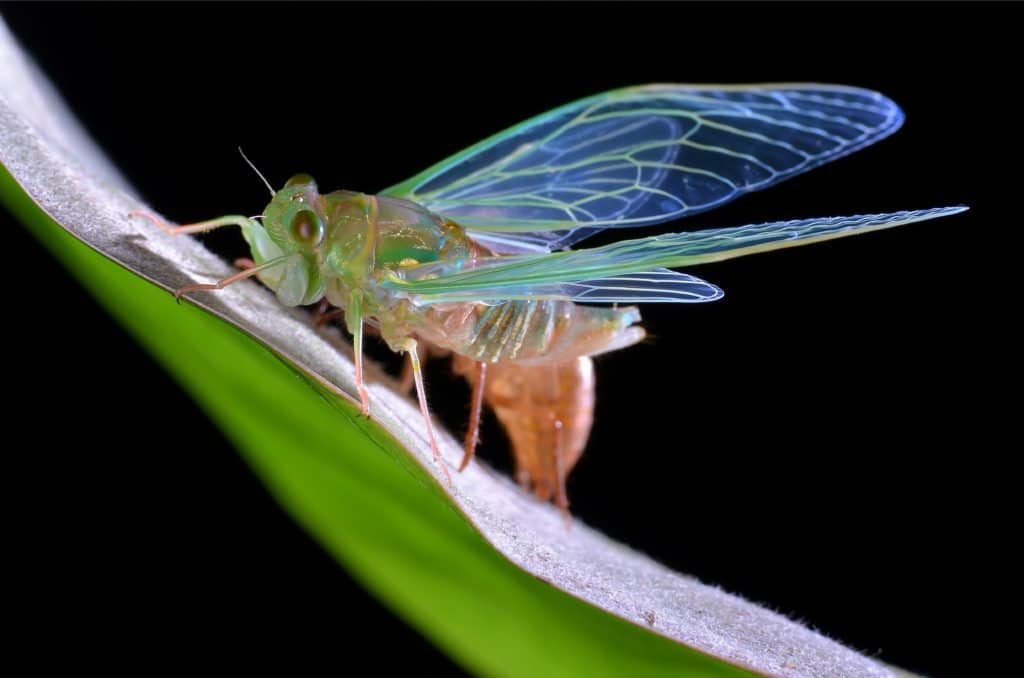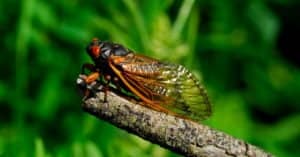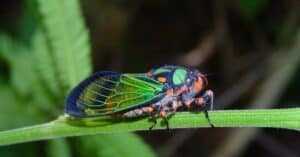For the first time in 17 years, Cicada Brood X will be emerging during the late spring and early summer of 2021. Cicadas can be a nuisance and those squeamish about bugs tend to hate having to duck the giant swarms of big bugs. They can also be surprisingly noisy. So if you live in Pennsylvania or the surrounding area where these cicadas are expected to emerge, you might be worried. If you’re a gardener, you’re probably wondering whether or not they will have a serious impact on your garden and your tomatoes in particular.
Do Cicadas Like to Eat Vegetation?
One of the most common misconceptions about cicadas is that they will strip an area of vegetation after they emerge. This myth comes from the fact that many people assume that cicadas and locusts are the same thing. In actuality, locusts are members of the Acrididae family alongside grasshoppers. Meanwhile, cicadas are a member of the Cicadoidea family and are a completely different species.
Locusts are large, long-bodied insects that consume leaves and other plant tissue, travel in large swarms, and tend to die after their first year. Locusts do not discriminate in what kind of vegetation they consume. A large swarm can actually pose a serious threat to the local ecosystem. Most countries that have locust populations go to extensive measures to prevent serious damage. That’s because locusts are one of the primary causes of famine in the third world.
In contrast, cicadas have short bodies, travel in moderately-sized clouds, and can live to be up to 17 years old. Cicadas only eat tree sap and are not know to seriously damage the plants that they feed off of. Cicadas do not pose nearly the same threat to an ecosystem as locusts do. That means that there should be no cause for alarm when Brood X finally arrives in your neighborhood.

©SIMON SHIM/Shutterstock.com
What Cicadas Actually Eat
Cicadas primarily feed off xylem, the sap from trees, and other woody vegetation. Cicadas eat by using a piercing mouth part, very similar to the rostrum of a mosquito. This rostrum is inserted into the tree stem or root and used to suck out enough sap to satisfy the cicada for the day.
Unless your trees are very small and unhealthy, there is very little chance that they will be damaged by the presence of a cicada population. The special saliva that cicadas produce is capable of plugging up the holes after the rostrum is removed, ensuring that tree sap will not leak out of the root or stem. This means that trees that have been visited by a cicada will maintain their internal sap system and won’t become drained easily, even if there are many cicadas in the area.
Cicada nymphs are smaller than a grain of rice and are often too little to drink actual tree sap. Instead, these tiny insects will use their rostrums to drink from the root of grass blades and other small plants. The need for easy access to grass for the nymphs is why you are likely to find cicada swarms at the edge of forests rather than in the middle of them.
Cicadas and Your Tomato Plants
As a gardener, you’ll be relieved to know that Cicada Brood X is not actually coming to feast on your tomato plants. Tomatoes do not produce the xylem that cicadas are looking for, and tomato juice is not a suitable replacement. Because of this, you’re really not likely to find cicadas hanging out in your garden.
The only time cicadas might eat your vegetables is if there are nymphs underground that might be snacking on the root system. However, due to the way cicadas eat, there is very little chance that they will do enough damage for you to even notice a difference in your tomatoes.
Although they don’t go for tomato plants, cicadas have been known to feed on fruit trees, berry bushes, and other similar types of woody vegetation that are capable of producing xylem. Again, there is very little risk that a cicada presence will damage these plants; however, you can avoid purchasing them if you do not want a cicada presence in your garden.
How Cicadas Might Damage Your Plants or Orchard

©Jonathan Steinbeck/Shutterstock.com
Cicadas don’t damage plants by feeding off them, but they do have a mildly destructive tendency that many gardeners complain about. When a female cicada deposits her eggs, she does so by cutting a v-shaped slit in a tree branch or plant stem and laying the eggs inside. These slits are larger than expected and can cause the attached branch or stem to flag or even break.
If your plants and trees are healthy, egg slits shouldn’t cause long-term damage. However, if a tree is particularly weak, it might not be able to sustain the nesting of multiple cicadas at once. Keep an eye on your garden during cicada breeding season, which occurs shortly after emergence. If you notice that once of your plants is suffering, start looking for egg deposits. As always, contact your local wildlife professionals before you attempt any kind of animal extermination or pest removal. Depending on the size of the local cicada population, it might be better to let the plant die to preserve a large collection of eggs. It’s also worth noting that unless the plant is already sick, a cicada presence very rarely results in it needing to be removed.
Residents in the area where Cicada Brood X is expected to emerge can rest comfortably with the knowledge that their precious gardens won’t be harmed by this exciting new bug presence. Start the season by making sure that your current plants are healthy and not at risk from other parasites. Then, sit back and enjoy the beautiful cicada hum that will soon be filling the air.
Cicada Brood X News & Information
Brood X is currently (spring 2021) emerging on the east coast of the United States. More information and coverage can be found here!
- Cicadas in New York: What’s Happening Now?
- Cicadas in Pennsylvania: What’s Happening Now?
- Cicadas in Virginia: What’s Happening Now?
- Cicadas in Tennessee: What’s Happening Now?
- Cicadas in Washington, DC: What’s Happening Now?
- Cicadas in Maryland: What’s Happening Now?
- Here’s What 1.5 Million Cicadas Looks Like
- Will Cicadas Cause More Snakes? Copperheads?
- Can Dogs Eat Cicadas?
- Will Cicadas Eat My Tomato Plants?
- Cicada Brood X 2021: What is it and should you be concerned?
- Why Do Cicadas Only Come Out Every 17 Years?
- Cicadas vs Locusts: What’s The Difference?
Up Next…
- Cicadas vs Locusts: What’s The Difference?: Are Locusts the same as Cicadas? Find out here everything you need to know about these insects.
- 10 Incredible Grasshopper Facts: Grasshoppers are a nuisance. Find out incredible and surprising facts about the grasshoppers.
- The Top 10 Largest Insects in the World: As long as we are on the subject of insects, here are the 10 largest animals in the world.
The photo featured at the top of this post is © Marcos Cesar Campis/Shutterstock.com
Thank you for reading! Have some feedback for us? Contact the AZ Animals editorial team.





